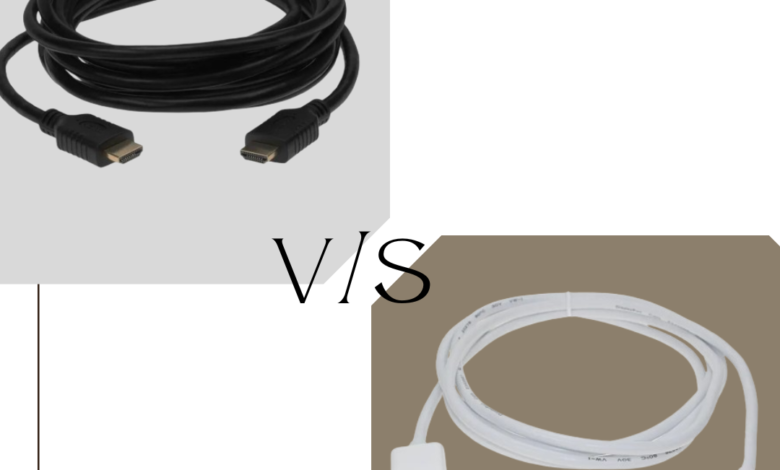Distinction Between DisplayPort Cable and HDMI Cables – Which is Better to Use?

Do you want to connect your new monitor to your computer? Does it make you think about whether to use a Display port or HDMI? Regardless of what you need to know about the capabilities and compatibility of various ports, knowing which one is important is crucial before making a purchase.
Additionally, you should know that there are two ports on the computer present that appear a lot similar. These are for Display port and HDMI to select from. However, the answer to this totally depends on what you are looking for. As computers used for different purposes, choose the computer cords accordingly.
Understanding DisplayPort Cable
Display Port cables have widely used over the years or expensive desktop monitors and graphic cards. It has an L-shaped header and an asymmetric connector. Even if the Display Port is not as widely used as HDMI at the moment, it is nevertheless an essential hardware standard with several uses as cable and connection technologies.
Coming terms of how it works, its operation is the same as that of other data connection protocols. Display port must plugged into appropriate devices with supporting slots on both ends by the user. Whereas, the users of older systems may need to manually choose the Display Port input and adjust the refresh rate alongside resolution. This can done easily using the display device’s control panel.
Benefits of Using Display Port Cables
There are several benefits of using the Display Port cables, including
- Display port offers a higher range of bandwidth than HDMI, which promotes higher resolution.
- It comes with the feature of Adaptive Sync technologies that reduce screen tearing and stuttering.
- Because of the daisy chaining feature, it helps connect multiple monitors.
- This cable allows to drive multiple monitors from one DisplayPort connection.
Understand HDMI Cables
It links a data source like a CPU or a set-top box to output devices like televisions, projectors, desktop monitors, laptops and more. The main purpose of HDMI cables is to provide a common protocol for connecting devices.
Its goal is to enable faster data throughout to meet the demands of high-definition video content and improve connectivity standards. Ever since developers created HDMI in 2002, people have used it in various devices. It is the most common cable for electronics like computers and televisions.
Benefits of Using HDMI Cables
There are several benefits of using HDMI cables including
- This cable the most widely used, ensuring compatibility with a range of devices.
- It is highly compatible and supports features like an Audio Return Channel ( ARC) and Consumer Electronic Control ( CEC).
- Not only does HDMI support high-definition video but audio as well through a single cable.
Difference Between Display Port Cable Vs HDMI Cables
Before you choose computer cords for your desktop, knowing the difference between the two cables is crucial. Let’s check them out by reading until the end.
| Difference | Display Port Cables | HDMI Cables |
| Development | The 1.0 Display Port Cables were the first version of the technology. It was introduced in the year of 2006 and was used a total of four to deliver a data transfer rate of 8.64 Gbps. Following this, a range of other cables were established like Display Port 1.1, 1.2,1.3,1.4 until the final version of 2.0 arrived in the year of 2019 at 48 Gbps. | The 1.0 HDMI cables were also the first version to be created of this technology. It was introduced in 2002 so that the high-definition audio and videos can be supported and transferred at 4.95 Gbps. Similar versions of HDMI also arrived like 1.1, 1.2, 1.3, and 1.4, 2.0 until 2.1 was launched in 2017 with the capability of 8K at 60 Hz. |
| Purpose | A DisplayPort is a digital interface designed to guarantee smooth video and audio delivery over a single connection. It transmits audio and video data for processing and output while connecting a display to a data source. | There are four sizes of HDMI connectors including normal, mini, micro and automobile. As each has a different function, their requirements differ. Both individual consumers and businesses usually employ Type A or standard HDMI connectors. They link source devices to TVs and monitors like Blu-ray players, game consoles and more. |
| Function | Multiple displays can operate simultaneously on a single connection because of DisplayPort standards. When four screens are connected to a single one, it offers consistent performance and amazing HD quality. As long as the maximum bandwidth is not exceeded, the connection will continue to work even when monitors are linked. However, this can cause the performance to diminish. Additionally, the DisplayPort cables can support CEC functions. To inform you more, these ports do not support ethernet functionality or audio return signals. | Not every HDMI version comes with the ability to support multiple monitors by default. To complete the process, a DisplayPort hub converter is needed. When it comes to the HDMI, the CEC capability is included. It was developed as a consumer electronics standard. This makes it possible for HDMI to manage the main device or any attached display using only one remote control. Moreover, a unique HEC function that enables built-in HDMI ethernet channel capabilities is available with the most recent version of HDMI. This allows audio control functions and provides users with an internet speed of up to 100 Mbps over HDMI connections. |
Which one Should Chosen – HDMI or Display Port?
Once you understand difference between DisplayPort cables and HDMI cables, you need to decide which one to choose. Let us help you make the best choice. So let’s help you out a little more to make the best choice.
- Check the Compatibility of the Device
When choosing between HDMI cables and DisplayPort cables, verify that the device supports the selected interface. DisplayPort is not as widely used or readily accessible as HDMI.
- Look at the Features
The next thing to look at when purchasing computer cords is to take a look at the features. You should consider choosing the cord that offers features like Adaptive Sync and daisy chaining for the configuration.
- Check the Refresh and Resolution Rate
DisplayPort can be a better option if you need more resolutions or refresh rates.
Version 2.0 of DisplayPort, the most recent version, has a refresh rate and resolution so high that it might be hard to find. This is because there are supply chain problems that have persisted since the epidemic.
- Consider Future Proofing
Make sure to consider what you might require in the future. When considering this, it would be ideal to select an interface that can best handle the updates and technological breakthroughs. The best video interface to utilise these computer cords will depend on the particular use case, configuration of the video card, technical requirements of the display, and more.




